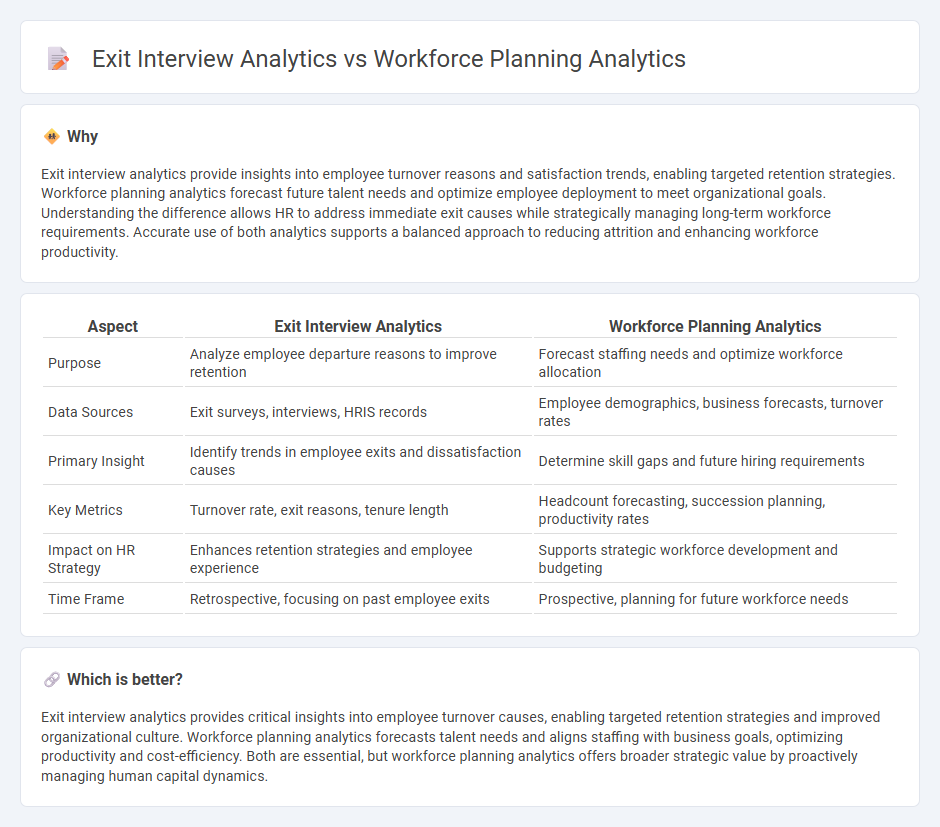
Exit interview analytics provides critical insights into employee turnover reasons by analyzing departure data, enabling organizations to identify trends and areas for retention improvement. Workforce planning analytics focuses on forecasting talent needs and optimizing resource allocation to align with organizational goals and market demands. Explore the differences and benefits of these analytics to enhance comprehensive human capital strategy.
Why it is important
Exit interview analytics provide insights into employee turnover reasons and satisfaction trends, enabling targeted retention strategies. Workforce planning analytics forecast future talent needs and optimize employee deployment to meet organizational goals. Understanding the difference allows HR to address immediate exit causes while strategically managing long-term workforce requirements. Accurate use of both analytics supports a balanced approach to reducing attrition and enhancing workforce productivity.
Comparison Table
| Aspect | Exit Interview Analytics | Workforce Planning Analytics |
|---|---|---|
| Purpose | Analyze employee departure reasons to improve retention | Forecast staffing needs and optimize workforce allocation |
| Data Sources | Exit surveys, interviews, HRIS records | Employee demographics, business forecasts, turnover rates |
| Primary Insight | Identify trends in employee exits and dissatisfaction causes | Determine skill gaps and future hiring requirements |
| Key Metrics | Turnover rate, exit reasons, tenure length | Headcount forecasting, succession planning, productivity rates |
| Impact on HR Strategy | Enhances retention strategies and employee experience | Supports strategic workforce development and budgeting |
| Time Frame | Retrospective, focusing on past employee exits | Prospective, planning for future workforce needs |
Which is better?
Exit interview analytics provides critical insights into employee turnover causes, enabling targeted retention strategies and improved organizational culture. Workforce planning analytics forecasts talent needs and aligns staffing with business goals, optimizing productivity and cost-efficiency. Both are essential, but workforce planning analytics offers broader strategic value by proactively managing human capital dynamics.
Connection
Exit interview analytics provide critical insights into employee turnover patterns, which directly inform workforce planning analytics by highlighting trends in attrition, reasons for departure, and skill gaps. Integrating exit interview data with workforce planning enables HR teams to develop targeted retention strategies and optimize recruitment efforts based on predictive workforce models. This connection enhances organizational agility by anticipating talent needs and reducing the cost and impact of employee turnover.
Key Terms
**Workforce Planning Analytics:**
Workforce planning analytics involves analyzing employee data to predict staffing needs, optimize talent allocation, and improve overall organizational performance through data-driven decision-making. It leverages predictive models, trend analysis, and workforce metrics to align human capital strategies with business goals. Explore more about how workforce planning analytics can transform your talent management strategies.
Talent Forecasting
Workforce planning analytics leverages predictive models and historical workforce data to accurately forecast talent needs and identify potential skill gaps, enabling proactive hiring and development strategies. Exit interview analytics analyzes employee turnover patterns and reasons for departure, providing critical insights to reduce attrition and improve retention efforts. Explore how combining these analytics enhances talent forecasting and strategic workforce decision-making.
Skills Gap Analysis
Workforce planning analytics utilizes data-driven insights to identify current and future skills gaps by analyzing employee capabilities, job requirements, and market trends to ensure strategic talent development. Exit interview analytics provide qualitative and quantitative feedback on reasons for employee turnover, revealing skill deficiencies and training needs that impact retention and performance. Explore how integrating these analytics can optimize your skills gap analysis for more informed workforce decisions.
Source and External Links
7 Essential Steps to Analytics-Driven Workforce Planning for 2025 - Predictive workforce planning analytics leverage AI and data to forecast hiring needs, identify workforce gaps, and reduce turnover, enabling organizations to make proactive HR decisions aligned with growth goals.
Workforce Planning Analytics: A Comprehensive Guide - Teramind - Workforce planning analytics provide insights that help managers forecast staffing needs, pinpoint skill gaps, anticipate turnover, and support data-driven staffing decisions to meet business performance goals.
What Is Workforce Analytics? Your 2025 A-Z Guide - AIHR - Workforce analytics is the systematic use of data to optimize HR decisions, including identifying skills gaps, forecasting staffing needs, succession planning, improving retention, and aligning workforce strategies with business objectives using predictive and performance analytics.
 dowidth.com
dowidth.com